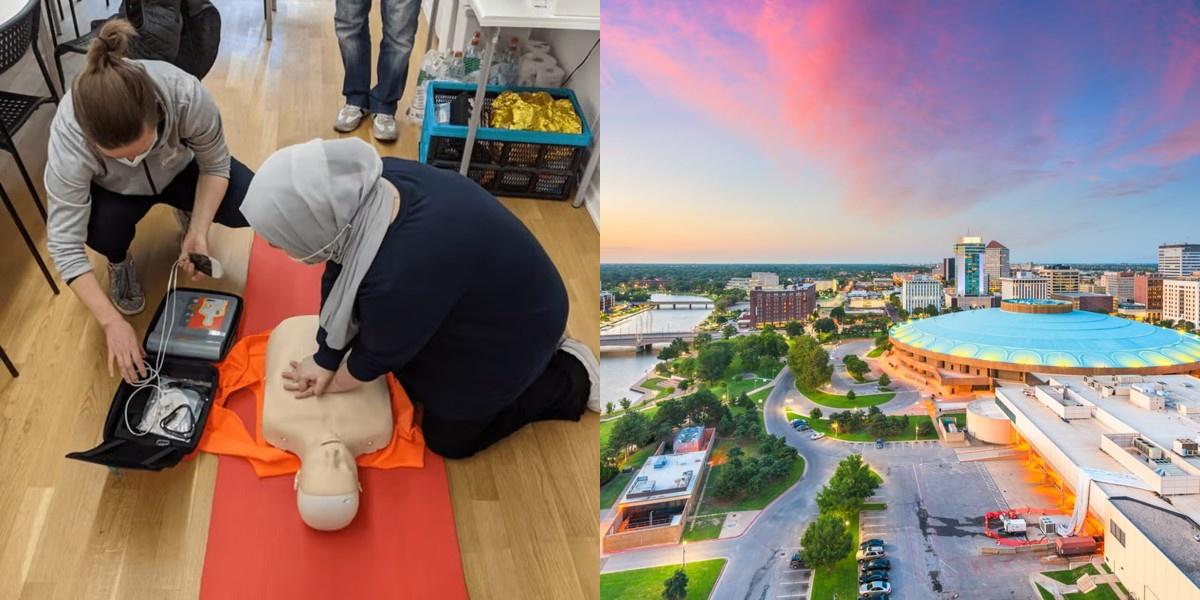What is a Paramedic?
A paramedic is a healthcare professional trained to manage emergency medical situations. Their responsibilities include:
- Assessing patients and stabilizing critical conditions.
- Administering medications and performing advanced life-saving techniques.
- Coordinating with healthcare teams to ensure patients receive the best care.
Where Do Paramedics Work?
Paramedics work in a variety of environments, often in high-stress and urgent care situations, including:
- Ambulance Services: Transporting patients to hospitals and providing emergency care on the scene.
- Hospitals: Assisting emergency rooms in critical care.
- Fire Departments: Many fire departments require paramedics to provide emergency medical care.
- Industrial or Remote Areas: Paramedics may be employed by large companies to offer healthcare support on-site.
- Law Enforcement: Some paramedics work with police to provide medical assistance in crisis situations.
Requirements to Become a Paramedic in Kansas
To become a paramedic in Kansas, you must meet certain education and legal requirements. These include:
-
High School Diploma or GED: You must have a high school diploma or equivalent to enroll in a paramedic training program.
-
EMT-B Certification: Before becoming a paramedic, you must first become certified as an Emergency Medical Technician (EMT)-Basic in Kansas. This involves completing an approved EMT-B training program and passing the National Registry of Emergency Medical Technicians (NREMT) exam.
-
Paramedic Training Program: After obtaining EMT-B certification, you can enroll in a paramedic training program. These programs are typically offered by community colleges, technical schools, or hospitals and can take anywhere from 6 months to 2 years to complete.
-
NREMT Paramedic Certification: Once you have completed your paramedic training program, you must pass the NREMT paramedic certification exam to become a certified paramedic in Kansas.
-
State Licensure: In addition to NREMT certification, you must also apply for state licensure through the Kansas Board of Emergency Medical Services.
How to Become a Paramedic in Kansas?
Becoming a paramedic in Kansas involves several key steps:
1. Earn a High School Diploma or GED: This is the foundational educational requirement.
2. Complete an EMT-Basic Program: Enroll in an accredited Emergency Medical Technician (EMT) program, which typically takes 1–2 semesters. Upon completion, pass the National Registry of Emergency Medical Technicians (NREMT) exam to obtain EMT certification.
3. Gain Experience as an EMT: Work as an EMT to build hands-on skills and confidence in emergency situations.
4. Enroll in a Paramedic Training Program: After gaining experience, enroll in an accredited paramedic program, which includes coursework and clinical rotations. These programs typically last 1–2 years.
5. Obtain NREMT Paramedic Certification: After completing training, pass the NREMT paramedic certification exam to become a certified paramedic.
6. Apply for Kansas State Licensure: Submit your NREMT certification and apply for licensure through the Kansas Board of Emergency Medical Services.
How Do I Get My Paramedic Certification?
Becoming a paramedic is an exciting and rewarding career choice. Paramedics are highly skilled professionals who provide emergency medical care to those in need. If you are interested in pursuing a career as a paramedic, here are the steps you need to take to get your paramedic certification.
1. Meet the basic requirements: Before beginning your paramedic training, ensure you meet the prerequisites. These generally include being at least 18 years old, having a high school diploma or equivalent, holding a valid driver's license, and being CPR certified.
2. Complete an EMT-Basic course: Start by becoming certified as an Emergency Medical Technician (EMT) at the basic level. This involves completing an EMT-Basic course, typically lasting around six months. During this training, you'll learn fundamental skills in providing basic life support and emergency medical care.
3. Gain practical experience: After finishing your EMT-Basic course, gain hands-on experience by working as an EMT. This practical experience is crucial for developing your skills in emergency medical care. You can work with ambulance services, hospitals, or fire departments to gain this experience.
4. Complete a paramedic training program: Once you've acquired sufficient experience as an EMT, enroll in a paramedic training program offered by community colleges, technical schools, or universities. These programs usually last between one to two years. Here, you'll learn advanced medical skills including anatomy, physiology, pharmacology, patient assessment, trauma care, and medical interventions.
5. Pass the national certification exam: After completing your paramedic training, you'll need to pass the national certification exam administered by the National Registry of Emergency Medical Technicians (NREMT). This exam tests your knowledge and skills in emergency medical care.
6. Obtain state licensure: Alongside national certification, you'll need to obtain state licensure as a paramedic. Each state has its own requirements, so check with your state's regulatory agency for specifics on licensure.
7. Maintain certification and licensure: Once certified and licensed, it's important to stay current with continuing education requirements. This involves completing ongoing training to stay informed about advancements in emergency medical care and maintain your ability to provide high-quality patient care.
How Do I Get a Job as a Paramedic?
After obtaining your paramedic certification and licensure, you may be wondering how to get a job as a paramedic. Here are some steps you can take to increase your chances of finding employment as a paramedic:
1. Build a strong resume: A well-crafted resume is essential for getting noticed by potential employers. Make sure to include your paramedic certification, any additional certifications or training you have, your education, and any relevant work experience. Highlight any specialized skills or areas of expertise that may set you apart from other candidates.
2. Network within the field: Networking is an important part of any job search. Reach out to people you know who are already working in the field of emergency medical services and let them know you are looking for a job as a paramedic. Attend industry conferences, job fairs, and networking events to meet professionals in the field and make connections.
3. Apply for jobs: Once you have a strong resume and have built a network of contacts, it's time to start applying for paramedic jobs. Look for job postings on online job boards, hospital and ambulance service websites, and professional organizations. Tailor your resume and cover letter to each specific job application to highlight your relevant skills and experience.
4. Prepare for interviews: If your application is successful, you may be invited for an interview. Take the time to prepare for the interview by researching the organization, practicing common interview questions, and preparing examples of how you have demonstrated your skills and experience in previous roles. Dress professionally and arrive on time for the interview.
5. Consider additional certifications or training: Having additional certifications or training can make you a more competitive candidate for paramedic jobs. Consider obtaining certifications in specialized areas such as advanced cardiac life support (ACLS), pediatric advanced life support (PALS), or critical care paramedic (CCP). These additional certifications can demonstrate your commitment to ongoing professional development and may open up additional career opportunities.
6. Be open to different job opportunities: When starting out as a paramedic, it may be beneficial to be open to different job opportunities. Consider working for different types of organizations such as ambulance services, hospitals, fire departments, or private companies. Each type of organization may offer different benefits and opportunities for career growth.
7. Stay current with industry trends: As a paramedic, it is important to stay current with industry trends and advancements in emergency medical care. Attend conferences, workshops, and continuing education courses to stay updated on the latest developments in the field. This will not only enhance your skills and knowledge but also demonstrate your commitment to providing the best possible care to your patients.
Career Paths and Opportunities
After becoming a paramedic, there are several career paths and opportunities available to you. Here are a few options to consider:
-
Advanced Paramedic: One option for career advancement is to become an advanced paramedic. Advanced paramedics have additional training and certifications that allow them to perform more advanced medical procedures and interventions. They often work in specialized areas such as critical care transport, flight medicine, or tactical medicine.
-
Supervisor or Manager: As you gain experience as a paramedic, you may have the opportunity to take on a supervisory or managerial role. In these roles, you will be responsible for overseeing and managing a team of paramedics, ensuring that they are providing high-quality care and following protocols and procedures.
-
Instructor or Educator: If you enjoy teaching and sharing your knowledge with others, you may consider becoming an instructor or educator in the field of emergency medical services. As an instructor, you will be responsible for teaching and training future paramedics, as well as providing continuing education for current paramedics.
-
Emergency Room Technician: Another career path for paramedics is to work as an emergency room technician. In this role, you will provide support to medical staff in the emergency room, assist with patient care, and perform various medical procedures under the supervision of a physician.
-
Research or Public Health: If you have a passion for research or public health, you may consider pursuing a career in these fields. Paramedics with a strong background in research or public health can contribute to advancements in emergency medical care, develop protocols and guidelines, or work on public health initiatives.
-
Firefighter: Many paramedics also work as firefighters. Fire departments often require their firefighters to be certified as paramedics to provide emergency medical care in addition to firefighting duties. This can be a rewarding career choice for those who enjoy the excitement and challenges of both firefighting and emergency medical care.
-
International Opportunities: Becoming a paramedic can also open up opportunities to work internationally. Many countries have a high demand for qualified paramedics, especially in remote or underserved areas. Working as a paramedic in a different country can be a unique and rewarding experience that allows you to make a difference in the lives of people in need.
Frequently Asked Questions







